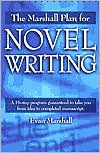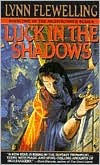Saturday, May 30, 2009
Interlude: Cool Meme Worth Checking Out
Before posting my Marshall Plan software review, I wanted to take a time-out to recommend a meme that Gabriele shared on her blog recently (link below). I'm not usually one for memes, but this one is actually a writing-related activity that is well worth the time. I haven't done it yet, but I will soon. It would clearly provide you with a stimulating, refreshing look at the characters in one of your novels.
Basically, you pick ten characters from one of your novels and assign them numbers at random (1-10). You then answer a bunch of questions which draw on your characters, but referring to them by number, so the way the characters fit into the questions is random (eg, "3 has to marry either 8, 4, or 9. Whom do they choose?"). It gets you thinking!
Gabriele's blog post is entitled "Another Meme, Because I'm Lazy" and it's dated "29.5.09". Check it out here. It's well worth your time.
Best wishes to all the characters out there (you know who you are),
Adrian
Saturday, May 16, 2009
The Marshall Plan 4: Keeping Organized
In summary, here's how to keep yourself organized while using The Marshall Plan. At least, it works for me.
First, brainstorm on your own. Write lists, write descriptions, make notes, outlines, tables, flow charts, draw sketches, do whatever you need to in order to come up with ideas for your story. Organize your notes in your own way to develop a sense of the flow of events. When you have your story clearly in mind, the major events, the major characters, the progression of major scenes from beginning to middle to end, then take what you have learned about your story and...
Second, develop your action/reaction sections using The Marshall Plan. This will involve rethinking your story and nailing things down in considerable detail. Exactly what happens when, in what order. For each section, you'll have the choice of which character should serve as the POV character, and you'll be able to specify exactly what his/her goal is, who the opposing character is, the complication(s) that arise, and how this ends (failure for the protagonist, success for the antagonist). If it's a reaction section, you'll be able to identify exactly what emotions the POV character is experiencing, and the key ideas that he/she considers when making a decision of what to do next.
After I brainstorm, and write, rewrite and rewrite again my various notes, condensing things, keeping what's good, tossing the rest, I print them out and put them in a three-ring binder. They're right up front, where I can easily find them and refer to them while writing. Sometimes while writing I need to look up a character name in my list of characters, or remember some detail in the magic system, or refer to a map or time line, etc.
After the notes, I print out the section sheets on colored paper so they stand out, and put them in the binder. My section sheets are done in two columns. The right column contains a page-long table that lists the POV character, goal, opposition character, etc. The left column contains notes that describe the scene and list any additional ideas that I want to be sure to include when I write the scene.
Finally, as I write the manuscript, I print out the sections (typically 4-6 typed pages) and put them in the binder after their corresponding section sheets.
This helps me in a couple of important ways. First, by planning before writing, the burden of thinking up a story is removed from the writing process. I create, then I write. When I write, I can focus on the story and how best to dramatize it. I can refer to the section sheet for the current section and remember what I had dreamed up previously while planning. I can focus on just that section and reflect on how to write it, then write it. I stay focused, knowing clearly what I'm trying to accomplish, and how it fits in with the rest of the story. Second, I can easily find things by laying them out in a binder. The colored paper marks the start of each section. The notes are on top. Since I've mapped the entire story out, it's easy to make changes. If I change an important detail in one scene, I know immediately which other scenes will be affected, and I can go to them directly and make the necessary adjustments.
Being hyper-organized isn't for everybody, but I appreciate how it makes the job a lot easier, and how it keeps me on track. Scenes are so much easier to write when you've already imagined them, already thought your way through them, already planned for them. When you know what came before, and what comes next.
Next: The Marshall Plan Novel-Writing Software
But First: Here's my first 3-D film, which I made on the www.Xtranormal.com web site. You must be 18+ to view it!
Cheers,
Adrian
Saturday, May 02, 2009
The Marshall Plan 3: Sections
"Sections" as described in The Marshall Plan are like scenes, and some reviewers equate the two. However, they are not necessarily the same thing. Let me explain by using a stage play as an example.
Imagine a play begins with two characters walking out on stage, talking, then walking off. The audience would think, "Gee, that was the first scene". They'd probably be correct about that. Then, a third character comes out on stage and delivers a monologue, letting the audience hear his thoughts, and he walks off. Most people would regard that as Scene Two, and they'd probably be right. (It would depend on where the playwright chose to make the scene breaks).
But, what if two characters came out on stage, talked to each other, then stayed on stage. A moment later, the doorbell sounded, and that third character entered and talked to the other two? Was that one scene, or two?
Of course, it would depend on where the playwright chose to create scene breaks. He/she might have kept it all as one scene, but he/she might also have put a scene break just before the doorbell sounds. In that case, Scene One would involve two characters, and Scene Two would involve the same two characters plus a third character.
Playwrights typically break larger scenes into smaller scenes because it helps the people who will perform their plays. The director can say, "Let's rehearse Scene One," and everyone will know that only two actors are needed on stage. The third actor can hang out in his dressing room with the rest of the cast and brag about the reviews of his last performance. But, if the director calls for a rehearsal of Scene Two, then everybody knows that three actors are needed, two on stage and one hiding behind the door, ready to walk out on stage.
Are sections scenes? It's sort of like the example above. A section could be a scene, or a part of a scene, but a section clearly stands on its own as a distinct unit. Scenes are made up of sections, always at least one, possibly more. Sections are the basic building blocks.
So, what is a section?
A section is just that -- a section of continuous text, made up of paragraphs, maybe some dialog, lasting something like 1250 words. That's just long enough that the reader can get pulled into the story and experience something significant and meaningful, and just short enough that the reader can do this within a matter of minutes, rather than needing an hour or two. By breaking your novel down into shorter sections, you allow your readers to focus, read, get something out of it, then look up and deal with whatever distraction is pulling them away from their reading, before focusing again and tackling the next section. You can make one section into a stand-alone scene, or you can join two sections together into one larger scene, but each section will still stand on its own, a "mini-scene" that is satisfying and complete in its own right.
In the Marshall Plan, there are two kinds of sections: action and reaction. Most sections are action sections in which one point-of-view character acts to meet one specific goal. Standing in the way is one opposition character who generates one or more obstacles, and the matter is resolved in some appropriate way by the end of the section. For the protagonist, this will be in some kind of failure. For the antagonist, the section will end in success. The antagonist's success translates as failure for the protagonist, and vice versa. Each action section ends with the setting of a new goal, although that goal is usually not expressed (the POV character will think it, but the reader will not read about it until the next section). The only time a new goal is not set is when the setback was so great that the POV character needs more time to deal with the emotions that arose from the failure. In this instance, the action section is followed by a reaction section.
In the reaction section, the POV character deals first with the emotions that resulted from the prior setback, then thinks the situation over and determines his/her next course of action (new goal). Hence, a reaction section has two key phases: "emotional" and "rational".
When you divide a novel into sections, you break it down into smaller, more manageable chunks. When you map out the sections, using the template given in The Marshall Plan (and fully automated for you if you use the new software), then you produce a series of short steps that you can follow with the sort of clarity and focus that those who don't plan can only dream of. The first time I fully plotted a novel using The Marshall Plan software, I was able to write 21,000 words of new material in one day. My previous record was about 9,000 words. I had always used much longer scenes, typically 2500 - 3,000 words, sometimes 5,000 - 10,000 words long. Far too long. When I worked with smaller sections, averaging about 1250 words, it felt like an enormous weight had been lifted off my shoulders. I could focus like never before, knowing that I had to be very concise, very focused, to deliver the drama I had planned for in such a short space. I sought the best way to dramatize the key struggle (goal-conflict-resolution). I didn't have to wonder what the goal was, what the basic struggle was, or how the section was supposed to end. It was all laid out for me, thanks to careful planning. What a difference!
As followers of my blog know, I plan extensively as a matter of habit. But the Marshall Plan's constant emphasis on shorter, more manageable sections, on goal, complication, failure and new goal kept me on track like never before. The abstract became concrete. The Marshall Plan helped me to achieve a remarkable degree of clarity for each and every section, each and every scene, of the entire novel! The novel practically wrote itself since the planning had included the key pieces that drove each step of the story forward.
Adrian
The Marshall Plan 2: Genre and Story
In The Marshall Plan for novel writing, Evan Marshall encourages aspiring writers to choose a genre and stick to it. Face it, when you open a Stephen King novel, you expect a novel by Stephen King, not a novel by Nora Roberts (and vice versa). It would be difficult for Stephen King to come out with romantic fiction -- his readers would keep expecting something terrible, something other-worldly to happen. And if Nora Roberts wrote a horror novel, the horror element would likely turn off a large portion of her readers who are expecting romance, not zombies, aliens or supernatural forces. Writers are packaged and marketed just as their books are. Pick one thing that you love, that you do best, and stick with it. Follow the advice or not, but it's good advice.
Now, to story. If you choose to specialize in one genre, you will want to learn all about that genre. You will learn what is typical of the genre: length of published novels, types of characters, settings, goals and complications. You will know whether the story you envision would seem to fit into that genre, whether it is like other published novels, yet also unique. It's not good to be too unique. Your story should blend in at the same time it stands out.
The first step in developing a new story is to brainstorm. Come up with all the ideas you can. Develop a sense of who the characters are, what their goals are, the difficulties they will encounter, how the characters play off one another, how the villain's success equals the hero's failure, how things go from bad to worse, how twists and turns make the story more exciting. Make sure there is a convincing need for the protagonist to pursue his/her main story goal, a clear sense of why it matters and what the consequences of failure would be. Make sure the protagonist and antagonist are matched evenly for a good fight. If the villain is too powerful, it's not realistic that your weakling hero will win the fight. If your hero is too strong and the villain is too weak, then it's not a big deal when the hero wins. Oh, and make sure the hero wins -- readers want a happy ending. Don't disappoint them. Write notes, make lists, draft summaries, draw pictures. Do whatever you need to that helps you develop your basic story and its major plot lines. Then, use this material to help you plan out your novel in sections.
Next: What are sections?
Adrian
Subscribe to:
Comments (Atom)







